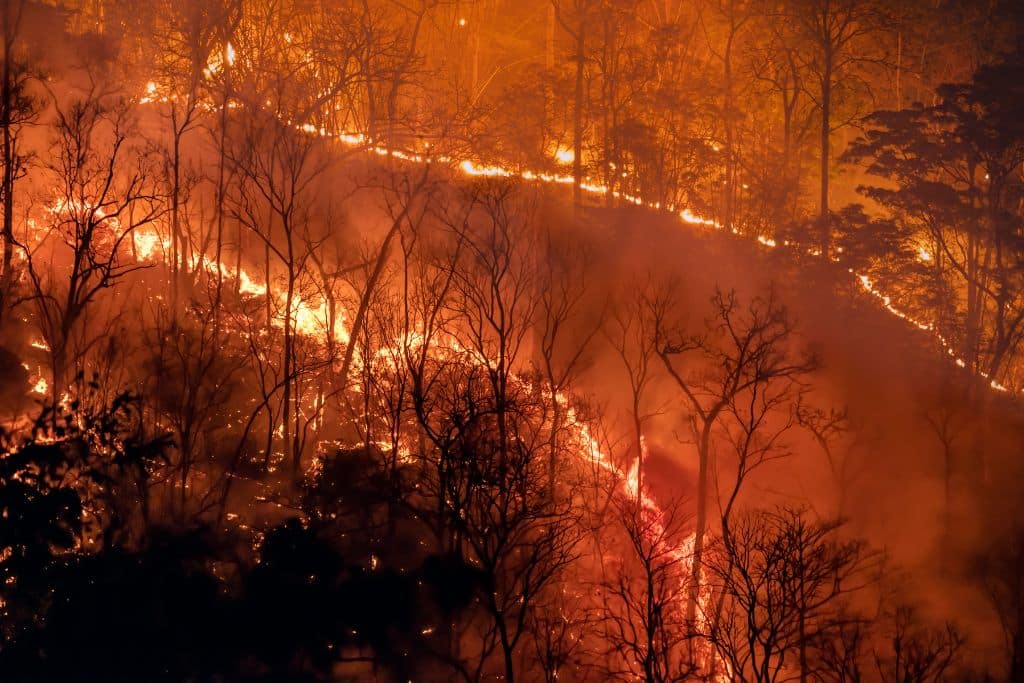In November, brush fires broke out in the northeastern US, sparking concerns for climate change and public health as a result of increased air pollution. As the planet continues to warm, people are increasingly concerned that these once uncommon events will become a recurring occurrence.
—
As Americans were getting ready to celebrate Thanksgiving last month, areas in the Northeast of the country experienced an onslaught of hazy, smokey air caused by brush fires in wooded areas in Brooklyn and New Jersey. The smoggy conditions spawned in one of the most heavily populated areas of the US, triggering red flag warnings and poor air quality alerts in New York City, New Jersey, and parts of Connecticut, according to NBC News.
Although wildfires are not unheard of, they are rare in this area.
While common in desolate, rural areas, brush fires can also occur in city parks after prolonged periods of dry weather and limited rainfall. As stated by the New York Police Department, brush fires are uncontrollable and spread quickly in urban environments.
While much remains to be understood about the enduring impacts of wildfires, prevailing climate patterns indicate that this may mark the inception of a more significant trend. As droughts intensify nationwide, they foster ideal circumstances for swift fire ignition and spread, placing previously untouched regions in escalating jeopardy.
The planet and public health are at risk, and there are important considerations to make as we look to the future.
Unprecedented
In 2023, Canada saw its worst-ever recorded wildfire season. According to World Weather Attribution, they were a result of climate change and an increase in “fire weather” conditions across the board of eastern Canada. The group concluded that human-inflicted behavior has instigated droughts and dry weather that make wildfires 100 times more likely.
Shortly after wildfires in Canada broke out, air quality in parts of the northeastern US reached unhealthy levels as thick smoke blanketed New York and neighbouring states as far south as Mexico in a thick, orange haze.

New Yorkers described the conditions as “apocalyptic” as the sky turned orange, startling residents and commuters. The Air Quality Index rose from “Unhealthy” to “Very Unhealthy” and finally to “Hazardous,” affecting more than 98 million people in the area.
The world still recalls the devastating megafires that ravaged Australia in 2019-2020, coinciding with the onset of the Covid-19 pandemic. These infernos were forecasted to have profound repercussions on biodiversity. A study published in Nature projected that up to 900 plant and animal species have suffered severe consequences or remain in peril as a result of the ferocity of the fires. While scientists continue to unravel the enduring consequences of heightened natural infernos, one unequivocal truth emerges: the disruption to present-day biodiversity will echo for years ahead.
Environmental scientists feel strongly that wildfires have long-lasting effects as a result of poor air quality and should serve as a wake up call. Many health implications, including infertility, dementia, and heart conditions, correlate to prolonged exposure to smoke that causes tiny smoke particles to get lodged in the nose and lungs.
As World Meteorological Organization Deputy-Secretary-General Ko Barrett stated in September, “Climate change and air quality cannot be treated separately. They go hand-in-hand and must be tackled together.’”
Outlook
The escalating frequency of wildfires poses a multifaceted threat, exacerbating climate change and endangering public health. The Northeastern US, unaccustomed to such conditions, faces a pressing need to acknowledge and address the long-term implications of these events. Staying informed, proactively engaging, and fostering collective awareness are crucial steps to mitigate these risks and safeguard communities in the face of this evolving challenge.
This story is funded by readers like you
Our non-profit newsroom provides climate coverage free of charge and advertising. Your one-off or monthly donations play a crucial role in supporting our operations, expanding our reach, and maintaining our editorial independence.
About EO | Mission Statement | Impact & Reach | Write for us














